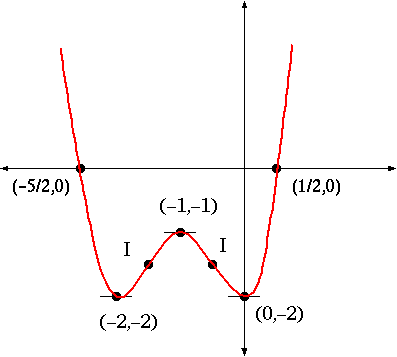
Example 5 f(x) = x4+4x3+4x2-2 .
Intercepts
Not every calculation can be equally easy for these functions. Typically, the problems you see in the texts have perhaps one, or two, of: intercepts, or critical points, or inflection points, easy to find. The others are usually difficult to evaluate. That is especially true with this problem. I do not want to find some 4-degree formula, like the quadratice formula, to solve it. Such a formula does exist, but you don't want to see it.
The only intercept we can easily find is the y -intercept at (0,-2) . I used Maple tro draw a graph, and saw that there are x -intercepts at about 1/2 and -5/2 (they are not exactly at those points, but close).
Increasing/decreasing, and critical points
f¢(x) = 4x3+12x2+8x , so critical points occur when
| ||||||||||||||||||||
| |||||||||||||||
| |||||||||||||||
In between, the sign of f¢(x) is given as follows:

f¢¢(x) = 12x2+24x+8 , so inflection points occur at solutions to
| |||||||||||||||
|
Here is the number line indicating the sign of the second derivative:

Use this information to draw a fair representation of the graph.
[Each of these items should trigger the appearance of a new drawing with that information added.]

Copyright (c) 2000 by David L. Johnson.